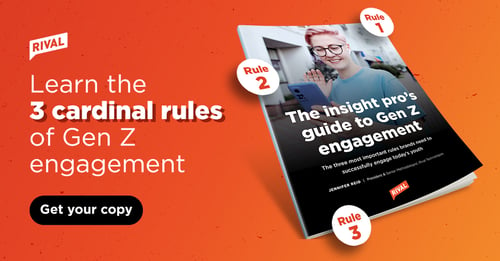
Today’s young consumers need marketers to meet them where they already exist, and to understand their needs and habits when they engage.
|
Note: This is the second article in a series of blog posts from our President and Chief Methodologist, Jennifer Reid, on how to engage Gen Zs and Millennials in the mobile age. To get notified of new content from this series and for more best practices for market research and insight professionals, subscribe to our blog. |
On any given day, most people sleep around seven to eight hours and devote just over an hour to eating and drinking. Yet over half of Gen Zs spend more time than that — 10-plus hours each day — on their various devices, toggling between an average of five different screens.
In retrospect, maybe we shouldn’t call them Generation Z at all. “Generation Tech” seems better suited.
After all, today’s young buyers are defined by their relationship with technology. When the iPhone was released, turning the smartphone into a must-have accessory, the oldest Gen Z was 10 years old. Younger Millennials ranged into their 20s. They don’t remember a time when they didn’t have information at their fingertips, not to mention on-demand music and online shopping options — with high-speed broadband giving them easy access to all three.

In a future post, I’ll discuss social media and the channels young people use to engage. Today, though, we’re going to explore that old adage, “The medium is the message,” and take a shallow dive into how tech has shaped young buyers and what it means for brands.
Today, 96% of Generation Z and 93% of Millennials own smartphones. The normalcy of technical innovations like these, along with fast Internet, abundant data, and the expansion of wireless access, have shaped how they interact in a multitude of ways. Let’s look at a few.
Texting and instant messaging are the primary forms of conversation for young people today. An average person aged 18 to 34 sends and receives 75 to 128-plus texts a day. Always on, those chats aren’t just a new form of email — they have a rhythm all their own, a continuous conversation that picks up then drops off again over time.
The TV isn’t a box on the wall anymore — at least not for this generation. Nielsen data shows that 18- to 34-year-old Americans watch significantly less TV than their older counterparts: one-and-a-half hours a day compared to an average of over four hours. Instead, all the media a young consumer wants is in the palm of their hand, a swipe of their screen or a flip of their laptop away.
Almost 90% of Gen Z consumers identify themselves as gamers — and they’re there for more than just the game. Research from our sister company, Reach3 Insights, shows that 90% see gaming as a great way to “hang out.” And they don’t want to be limited by their tech, either — cross-platform games have become one of the hottest trends.

Marketers engaging with today’s young people won’t get far if they don’t face this relationship with technology head on. Having an audience with a powerful portal that’s always connected to the world around them and always in the palm of their hand is an amazing opportunity to shake up old methods of engagement. With that in mind, there are a few tech rules we try to live by at Rival.
Mobile devices are the primary way young buyers today consume information and engage with brands. That clunky desktop website “optimized for the phone” just isn’t going to cut it. Young buyers expect to be able to buy from their phone as easily as they do in person.
Clunky desktop website “optimized for the phone” just isn’t going to cut it.
We can now pause a Netflix show on a laptop, change rooms and pick up where we left off on a smart TV. It’s no wonder, then, that young buyers aren’t committed to a single channel. They navigate online, mobile, and omnichannel experiences — and they want a continuous, positive experience across them all.
Stop assuming young people are sitting at their computers reading their email. They’re not. Instead, offer them ways to engage in a chat in real time or with a chatbot. This is how they want to provide feedback, share ideas, learn more, and get support.
Not only are younger people increasingly consuming media on their devices, they’re creating it too. There’s a wealth of opportunity to engage through the sharing of video (or photos) between young consumers and brands. Video killed the radio star!
Take advantage of those phones young people always have at the ready! Use flowcodes (or QR Codes) to help seamlessly integrate in-person and digital experiences. Popping open a camera to scan a code is second nature to this audience.
All of this goes to say that today’s young consumers need marketers to meet them where they already exist, and to understand their needs and habits when they engage. If marketers can’t do that, young buyers aren’t afraid to exercise their options — after all, there are plenty of other brands they can go to instead.
Subscribe to our blog to receive the latest news, trends and best practices from market research experts.

No Comments Yet
Let us know what you think